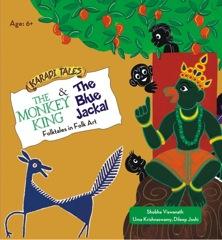

The Jataka body of fables and anecdotes, depicting earlier incarnations of the Buddha, has survived from 300 BC because the messages they conveyed through the parables are valid even in this day and age.
The Monkey King is one such story. A troop of monkeys lived in a far away jungle in which there grew a mango tree that yielded the most delicious fruit. Kapi, the king of the monkeys warned them not to let any fruit fall into the river, lest it be carried away by the current to human habitation., He knew once the humans had tasted the fruit they would descend upon their jungle and not only strip the trees bare but also seize the kingdom and destroy all of them. And that is exactly how events started to unfold. But, all was not lost, as Kapi, the monkey king was determined to save each and everyone of his troop even if it meant putting his own life in danger.
Illustrations in a medley of folk art styles, including Cheriyal, Mithila, miniature and textile arts, make for dramatic results.
The second story, The Blue Jackal, is about an underdog who by an act of fate became king. Of course, his disguise was only skin deep (literally) and soon his true self emerged to the fore and he was found out. This story also reinforces the age-old adage, that A leopard cannot change his spots.
Illustrations are in the Warli style of art, with a lot of interesting details that will engage a child.
Both these are anthropomorphic stories, in which human emotions, such as, kindness, jealousy, bravery, love, treachery, cowardice, inadequacies, are beautifully articulated. They subtly convey messages that children will carry with them for years to come.
A hard-bound well produced book that makes it a pleasure to flip through.